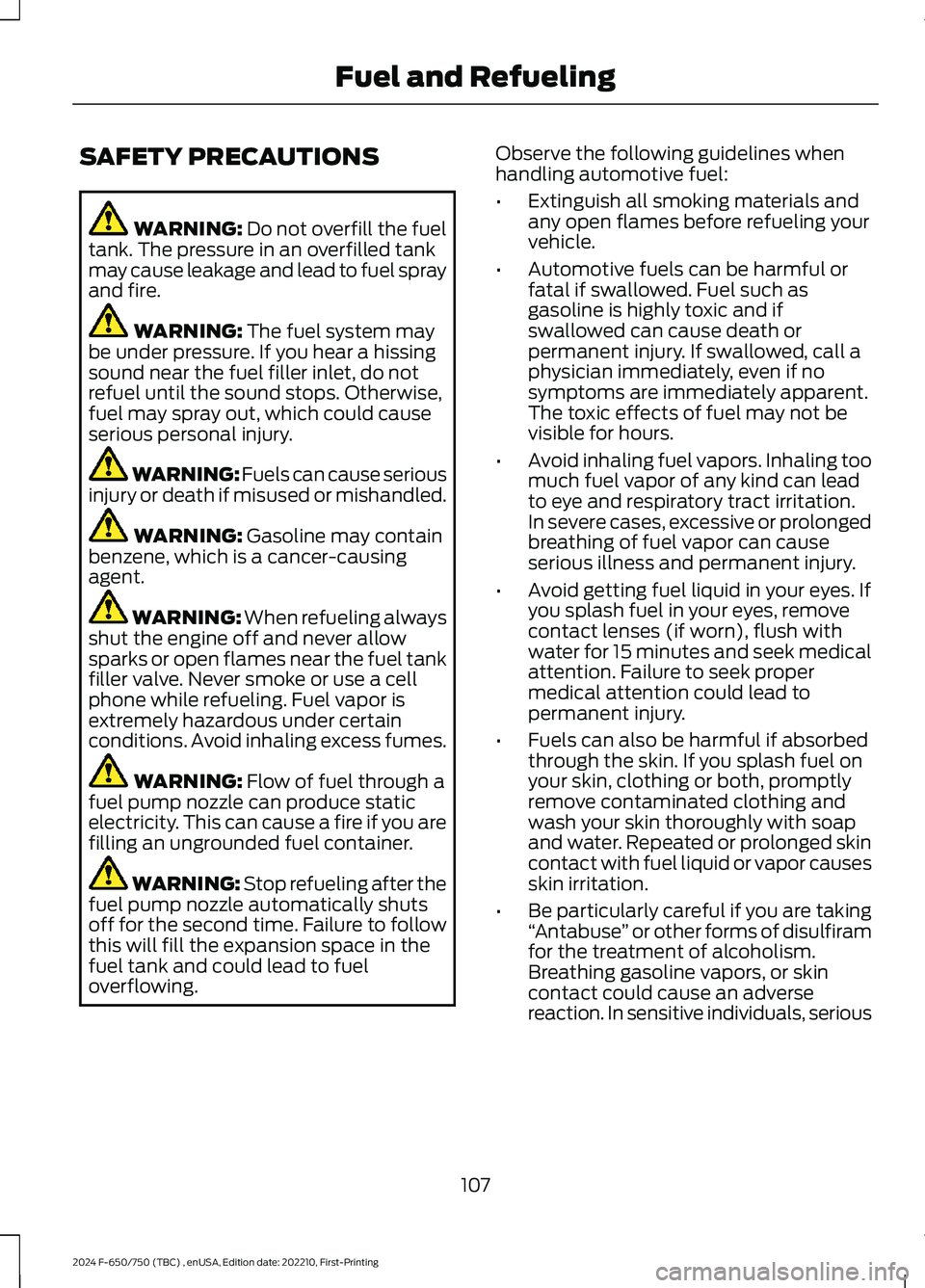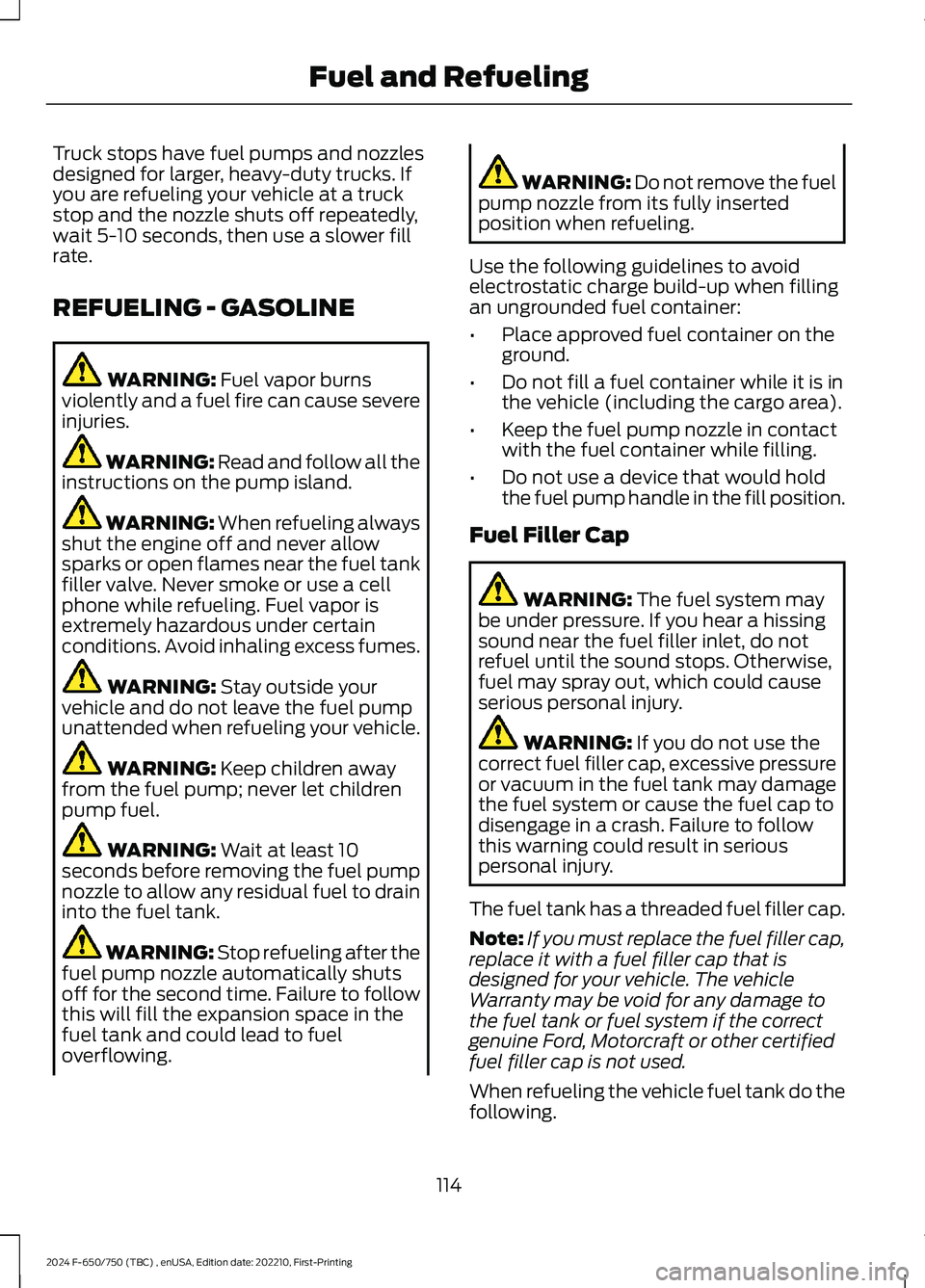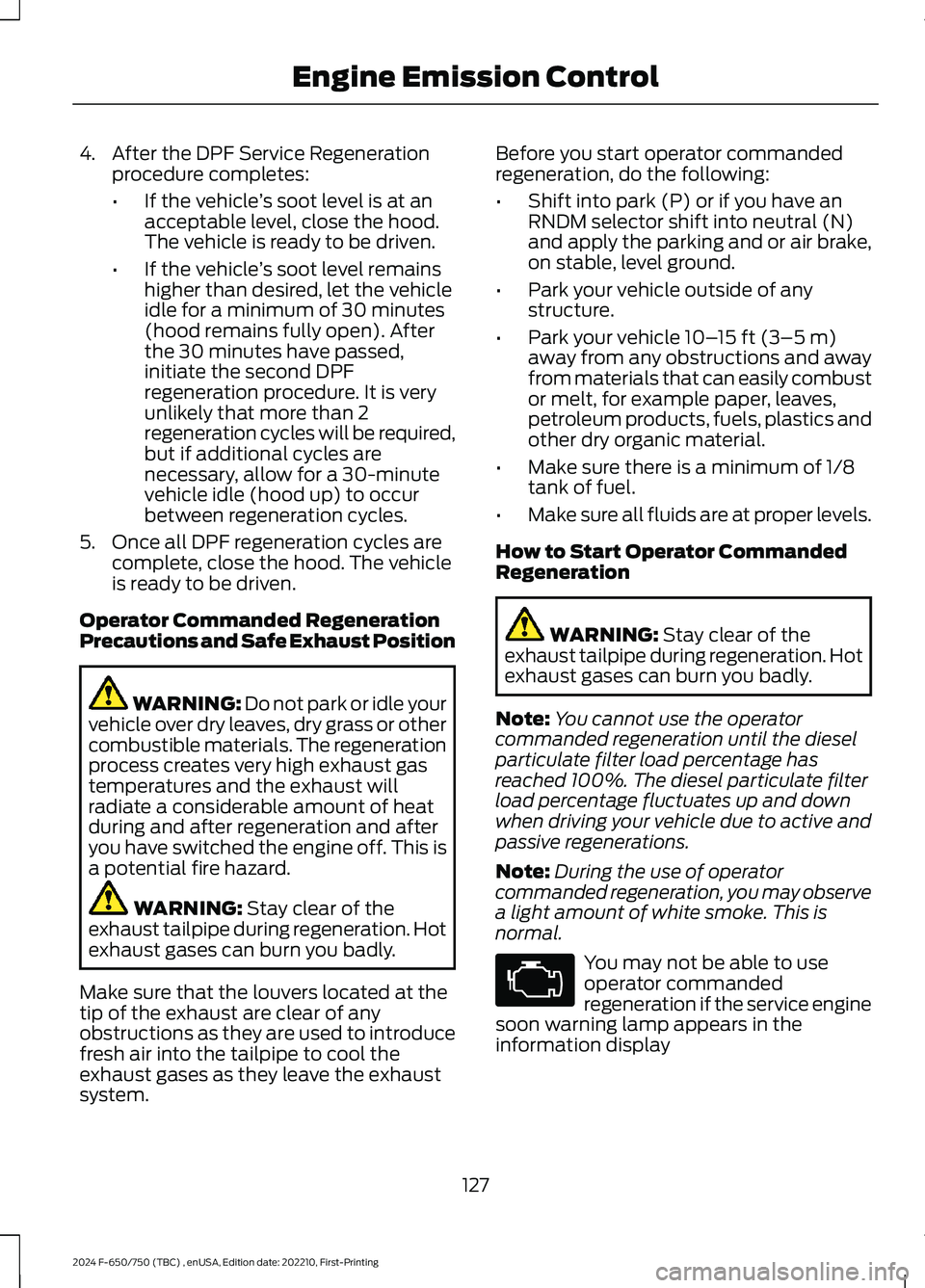2024 FORD F650/750 open gas tank
[x] Cancel search: open gas tankPage 111 of 386

SAFETY PRECAUTIONS
WARNING: Do not overfill the fueltank. The pressure in an overfilled tankmay cause leakage and lead to fuel sprayand fire.
WARNING: The fuel system maybe under pressure. If you hear a hissingsound near the fuel filler inlet, do notrefuel until the sound stops. Otherwise,fuel may spray out, which could causeserious personal injury.
WARNING: Fuels can cause seriousinjury or death if misused or mishandled.
WARNING: Gasoline may containbenzene, which is a cancer-causingagent.
WARNING: When refueling alwaysshut the engine off and never allowsparks or open flames near the fuel tankfiller valve. Never smoke or use a cellphone while refueling. Fuel vapor isextremely hazardous under certainconditions. Avoid inhaling excess fumes.
WARNING: Flow of fuel through afuel pump nozzle can produce staticelectricity. This can cause a fire if you arefilling an ungrounded fuel container.
WARNING: Stop refueling after thefuel pump nozzle automatically shutsoff for the second time. Failure to followthis will fill the expansion space in thefuel tank and could lead to fueloverflowing.
Observe the following guidelines whenhandling automotive fuel:
•Extinguish all smoking materials andany open flames before refueling yourvehicle.
•Automotive fuels can be harmful orfatal if swallowed. Fuel such asgasoline is highly toxic and ifswallowed can cause death orpermanent injury. If swallowed, call aphysician immediately, even if nosymptoms are immediately apparent.The toxic effects of fuel may not bevisible for hours.
•Avoid inhaling fuel vapors. Inhaling toomuch fuel vapor of any kind can leadto eye and respiratory tract irritation.In severe cases, excessive or prolongedbreathing of fuel vapor can causeserious illness and permanent injury.
•Avoid getting fuel liquid in your eyes. Ifyou splash fuel in your eyes, removecontact lenses (if worn), flush withwater for 15 minutes and seek medicalattention. Failure to seek propermedical attention could lead topermanent injury.
•Fuels can also be harmful if absorbedthrough the skin. If you splash fuel onyour skin, clothing or both, promptlyremove contaminated clothing andwash your skin thoroughly with soapand water. Repeated or prolonged skincontact with fuel liquid or vapor causesskin irritation.
•Be particularly careful if you are taking“Antabuse” or other forms of disulfiramfor the treatment of alcoholism.Breathing gasoline vapors, or skincontact could cause an adversereaction. In sensitive individuals, serious
107
2024 F-650/750 (TBC) , enUSA, Edition date: 202210, First-PrintingFuel and Refueling
Page 116 of 386

RUNNING OUT OF FUEL -
DIESEL
Avoid running out of fuel. This allows air toenter the fuel system and may make itdifficult to restart your vehicle.
If your vehicle runs out of fuel:
•Normally adding 4–5 gal (15–19 L) offuel is enough to restart the engine. Ifyour vehicle is out of fuel and on asteep grade, more than 5 gal (19 L)may be required.
•You must purge trapped air from thesystem before restarting the engine.
Purging Air From the System
Switch the ignition on for 30 seconds andthen switch the ignition off. Repeat thisoperation six times in a row to purge anytrapped air from the fuel system.
Any remaining air in the system self-purgeswhen the engine starts. The engine mayrun rough or produce white smoke whenair remains in the fuel system. This isnormal and stops after a short period. Ifthe engine continues to run rough, haveyour vehicle checked as soon as possible.
Starting the Engine
Do not crank the engine for more than 10seconds as starter damage may occur. Ifthe engine fails to start, switch the ignitionoff and wait 30 seconds before crankingthe engine again. See Starting a DieselEngine (page 103).
RUNNING OUT OF FUEL -
GASOLINE
Avoid running out of fuel because thissituation may have an adverse effect onpowertrain components.
If you run out of fuel:
•You may need to switch the ignitionfrom off to on several times afterrefueling to allow the fuel system topump the fuel from the tank to theengine. When restarting, cranking timetakes a few seconds longer thannormal. With keyless ignition, just startthe engine. Crank time will be longerthan usual.
•Normally, adding 1 gal (3.8 L) of fuel isenough to restart the engine. If thevehicle is out of fuel and on a steepgrade, more than 1 gal (3.8 L) may berequired.
•The service engine soon indicator maycome on. See Warning Lamps andIndicators (page 67).
REFUELING - DIESEL
WARNING: Fuel vapor burnsviolently and a fuel fire can cause severeinjuries.
WARNING: Read and follow all theinstructions on the pump island.
WARNING: When refueling alwaysshut the engine off and never allowsparks or open flames near the fuel tankfiller valve. Never smoke or use a cellphone while refueling. Fuel vapor isextremely hazardous under certainconditions. Avoid inhaling excess fumes.
WARNING: Stay outside yourvehicle and do not leave the fuel pumpunattended when refueling your vehicle.
WARNING: Keep children awayfrom the fuel pump. Never let childrenpump fuel.
112
2024 F-650/750 (TBC) , enUSA, Edition date: 202210, First-PrintingFuel and Refueling
Page 118 of 386

Truck stops have fuel pumps and nozzlesdesigned for larger, heavy-duty trucks. Ifyou are refueling your vehicle at a truckstop and the nozzle shuts off repeatedly,wait 5-10 seconds, then use a slower fillrate.
REFUELING - GASOLINE
WARNING: Fuel vapor burnsviolently and a fuel fire can cause severeinjuries.
WARNING: Read and follow all theinstructions on the pump island.
WARNING: When refueling alwaysshut the engine off and never allowsparks or open flames near the fuel tankfiller valve. Never smoke or use a cellphone while refueling. Fuel vapor isextremely hazardous under certainconditions. Avoid inhaling excess fumes.
WARNING: Stay outside yourvehicle and do not leave the fuel pumpunattended when refueling your vehicle.
WARNING: Keep children awayfrom the fuel pump; never let childrenpump fuel.
WARNING: Wait at least 10seconds before removing the fuel pumpnozzle to allow any residual fuel to draininto the fuel tank.
WARNING: Stop refueling after thefuel pump nozzle automatically shutsoff for the second time. Failure to followthis will fill the expansion space in thefuel tank and could lead to fueloverflowing.
WARNING: Do not remove the fuelpump nozzle from its fully insertedposition when refueling.
Use the following guidelines to avoidelectrostatic charge build-up when fillingan ungrounded fuel container:
•Place approved fuel container on theground.
•Do not fill a fuel container while it is inthe vehicle (including the cargo area).
•Keep the fuel pump nozzle in contactwith the fuel container while filling.
•Do not use a device that would holdthe fuel pump handle in the fill position.
Fuel Filler Cap
WARNING: The fuel system maybe under pressure. If you hear a hissingsound near the fuel filler inlet, do notrefuel until the sound stops. Otherwise,fuel may spray out, which could causeserious personal injury.
WARNING: If you do not use thecorrect fuel filler cap, excessive pressureor vacuum in the fuel tank may damagethe fuel system or cause the fuel cap todisengage in a crash. Failure to followthis warning could result in seriouspersonal injury.
The fuel tank has a threaded fuel filler cap.
Note:If you must replace the fuel filler cap,replace it with a fuel filler cap that isdesigned for your vehicle. The vehicleWarranty may be void for any damage tothe fuel tank or fuel system if the correctgenuine Ford, Motorcraft or other certifiedfuel filler cap is not used.
When refueling the vehicle fuel tank do thefollowing.
114
2024 F-650/750 (TBC) , enUSA, Edition date: 202210, First-PrintingFuel and Refueling
Page 131 of 386

4.After the DPF Service Regenerationprocedure completes:
•If the vehicle’s soot level is at anacceptable level, close the hood.The vehicle is ready to be driven.
•If the vehicle’s soot level remainshigher than desired, let the vehicleidle for a minimum of 30 minutes(hood remains fully open). Afterthe 30 minutes have passed,initiate the second DPFregeneration procedure. It is veryunlikely that more than 2regeneration cycles will be required,but if additional cycles arenecessary, allow for a 30-minutevehicle idle (hood up) to occurbetween regeneration cycles.
5.Once all DPF regeneration cycles arecomplete, close the hood. The vehicleis ready to be driven.
Operator Commanded RegenerationPrecautions and Safe Exhaust Position
WARNING: Do not park or idle yourvehicle over dry leaves, dry grass or othercombustible materials. The regenerationprocess creates very high exhaust gastemperatures and the exhaust willradiate a considerable amount of heatduring and after regeneration and afteryou have switched the engine off. This isa potential fire hazard.
WARNING: Stay clear of theexhaust tailpipe during regeneration. Hotexhaust gases can burn you badly.
Make sure that the louvers located at thetip of the exhaust are clear of anyobstructions as they are used to introducefresh air into the tailpipe to cool theexhaust gases as they leave the exhaustsystem.
Before you start operator commandedregeneration, do the following:
•Shift into park (P) or if you have anRNDM selector shift into neutral (N)and apply the parking and or air brake,on stable, level ground.
•Park your vehicle outside of anystructure.
•Park your vehicle 10–15 ft (3–5 m)away from any obstructions and awayfrom materials that can easily combustor melt, for example paper, leaves,petroleum products, fuels, plastics andother dry organic material.
•Make sure there is a minimum of 1/8tank of fuel.
•Make sure all fluids are at proper levels.
How to Start Operator CommandedRegeneration
WARNING: Stay clear of theexhaust tailpipe during regeneration. Hotexhaust gases can burn you badly.
Note:You cannot use the operatorcommanded regeneration until the dieselparticulate filter load percentage hasreached 100%. The diesel particulate filterload percentage fluctuates up and downwhen driving your vehicle due to active andpassive regenerations.
Note:During the use of operatorcommanded regeneration, you may observea light amount of white smoke. This isnormal.
You may not be able to useoperator commandedregeneration if the service enginesoon warning lamp appears in theinformation display
127
2024 F-650/750 (TBC) , enUSA, Edition date: 202210, First-PrintingEngine Emission ControlE67028
Page 383 of 386

Engine Coolant Check - 7.3L....................238Engine Emission Control.............................117Engine Idle Shutdown................................105Engine ImmobilizerSee: Passive Anti-Theft System......................51Engine Oil Capacity and Specification -6.7L Diesel...................................................296Engine Oil Capacity and Specification -7.3L.................................................................299Engine Oil Check...........................................227Engine Oil Dipstick - 6.7L Diesel.............227Engine Oil Dipstick - 7.3L...........................227Engine Specifications - 6.7L Diesel........291Engine Specifications - 7.3L.....................292Entering, Exiting or Climbing on ThisVehicle..............................................................18Environment.....................................................22Essential Towing Checks...........................183Event Data RecordingSee: Data Recording..............................................11Exhaust Brake................................................145Exhaust System Inspection.....................255Export Unique Options.................................18Exterior Mirrors.................................................61
F
Fastening the Seatbelts..............................39Federal Highway AdministrationRegulation.......................................................18Fifth Wheel Operation................................184Flat TireSee: Changing a Road Wheel........................287Ford Credit.........................................................15Ford Protect...................................................323Frame and Tow Hook Inspection..........260Front Seat Armrest........................................95Fuel and Refueling.......................................107Fuel Consumption.........................................115Fuel Filter - 7.3L............................................249Fuel Quality - Diesel....................................108Fuel Quality - Gasoline.................................111Fuel Tank Capacity - Diesel.....................303Fuel Tank Capacity - Gasoline...............304Fuel Tank Selector Switch.........................116Fuses................................................................202Fuse Specification Chart..........................202
G
Gauges...............................................................64GearboxSee: Transmission..............................................130General Driving Points................................186General Information on RadioFrequencies...................................................46General Maintenance Information........325Getting Assistance Outside the U.S. andCanada..........................................................199Getting the Services You Need...............196
H
HandbrakeSee: Parking Brake.............................................140Hazard Flashers............................................190Headlamp AdjustingSee: Adjusting the Headlamps.....................248Headlamp Exit Delay....................................56Headlamp RemovalSee: Removing a Headlamp..........................250HeadrestSee: Head Restraints..........................................89Head Restraints..............................................89Heated Exterior Mirrors................................88HeatingSee: Climate Control..........................................86Hill Start Assist - Vehicles With:Hydraulic Brakes........................................143Hints on Controlling the InteriorClimate............................................................87Hints on Driving With Anti-LockBrakes............................................................140Hood LockSee: Opening and Closing the Hood...........223Horn.....................................................................53How Does the Pneumatic LockingDifferential Work........................................137Hydraulic Power Steering Fluid Capacityand Specification.......................................312
I
Ignition Switch................................................101In California (U.S. Only)..............................197Information Display Control.......................53
379
2024 F-650/750 (TBC) , enUSA, Edition date: 202210, First-PrintingIndex